Daphne Ippolito
Shammie
NoveltyBench: Evaluating Language Models for Humanlike Diversity
Apr 08, 2025Abstract:Language models have demonstrated remarkable capabilities on standard benchmarks, yet they struggle increasingly from mode collapse, the inability to generate diverse and novel outputs. Our work introduces NoveltyBench, a benchmark specifically designed to evaluate the ability of language models to produce multiple distinct and high-quality outputs. NoveltyBench utilizes prompts curated to elicit diverse answers and filtered real-world user queries. Evaluating 20 leading language models, we find that current state-of-the-art systems generate significantly less diversity than human writers. Notably, larger models within a family often exhibit less diversity than their smaller counterparts, challenging the notion that capability on standard benchmarks translates directly to generative utility. While prompting strategies like in-context regeneration can elicit diversity, our findings highlight a fundamental lack of distributional diversity in current models, reducing their utility for users seeking varied responses and suggesting the need for new training and evaluation paradigms that prioritize diversity alongside quality.
Exploring and Mitigating Adversarial Manipulation of Voting-Based Leaderboards
Jan 13, 2025



Abstract:It is now common to evaluate Large Language Models (LLMs) by having humans manually vote to evaluate model outputs, in contrast to typical benchmarks that evaluate knowledge or skill at some particular task. Chatbot Arena, the most popular benchmark of this type, ranks models by asking users to select the better response between two randomly selected models (without revealing which model was responsible for the generations). These platforms are widely trusted as a fair and accurate measure of LLM capabilities. In this paper, we show that if bot protection and other defenses are not implemented, these voting-based benchmarks are potentially vulnerable to adversarial manipulation. Specifically, we show that an attacker can alter the leaderboard (to promote their favorite model or demote competitors) at the cost of roughly a thousand votes (verified in a simulated, offline version of Chatbot Arena). Our attack consists of two steps: first, we show how an attacker can determine which model was used to generate a given reply with more than $95\%$ accuracy; and then, the attacker can use this information to consistently vote for (or against) a target model. Working with the Chatbot Arena developers, we identify, propose, and implement mitigations to improve the robustness of Chatbot Arena against adversarial manipulation, which, based on our analysis, substantially increases the cost of such attacks. Some of these defenses were present before our collaboration, such as bot protection with Cloudflare, malicious user detection, and rate limiting. Others, including reCAPTCHA and login are being integrated to strengthen the security in Chatbot Arena.
Global MMLU: Understanding and Addressing Cultural and Linguistic Biases in Multilingual Evaluation
Dec 04, 2024



Abstract:Cultural biases in multilingual datasets pose significant challenges for their effectiveness as global benchmarks. These biases stem not only from language but also from the cultural knowledge required to interpret questions, reducing the practical utility of translated datasets like MMLU. Furthermore, translation often introduces artifacts that can distort the meaning or clarity of questions in the target language. A common practice in multilingual evaluation is to rely on machine-translated evaluation sets, but simply translating a dataset is insufficient to address these challenges. In this work, we trace the impact of both of these issues on multilingual evaluations and ensuing model performances. Our large-scale evaluation of state-of-the-art open and proprietary models illustrates that progress on MMLU depends heavily on learning Western-centric concepts, with 28% of all questions requiring culturally sensitive knowledge. Moreover, for questions requiring geographic knowledge, an astounding 84.9% focus on either North American or European regions. Rankings of model evaluations change depending on whether they are evaluated on the full portion or the subset of questions annotated as culturally sensitive, showing the distortion to model rankings when blindly relying on translated MMLU. We release Global-MMLU, an improved MMLU with evaluation coverage across 42 languages -- with improved overall quality by engaging with compensated professional and community annotators to verify translation quality while also rigorously evaluating cultural biases present in the original dataset. This comprehensive Global-MMLU set also includes designated subsets labeled as culturally sensitive and culturally agnostic to allow for more holistic, complete evaluation.
Measuring Non-Adversarial Reproduction of Training Data in Large Language Models
Nov 15, 2024Abstract:Large language models memorize parts of their training data. Memorizing short snippets and facts is required to answer questions about the world and to be fluent in any language. But models have also been shown to reproduce long verbatim sequences of memorized text when prompted by a motivated adversary. In this work, we investigate an intermediate regime of memorization that we call non-adversarial reproduction, where we quantify the overlap between model responses and pretraining data when responding to natural and benign prompts. For a variety of innocuous prompt categories (e.g., writing a letter or a tutorial), we show that up to 15% of the text output by popular conversational language models overlaps with snippets from the Internet. In worst cases, we find generations where 100% of the content can be found exactly online. For the same tasks, we find that human-written text has far less overlap with Internet data. We further study whether prompting strategies can close this reproduction gap between models and humans. While appropriate prompting can reduce non-adversarial reproduction on average, we find that mitigating worst-case reproduction of training data requires stronger defenses -- even for benign interactions.
Chasing Random: Instruction Selection Strategies Fail to Generalize
Oct 19, 2024Abstract:Prior work has shown that language models can be tuned to follow user instructions using only a small set of high-quality instructions. This has accelerated the development of methods that filter a large, noisy instruction-tuning datasets down to high-quality subset which works just as well. However, typically, the performance of these methods is not demonstrated across a uniform experimental setup and thus their generalization capabilities are not well established. In this work, we analyze popular selection strategies across different source datasets, selection budgets and evaluation benchmarks: Our results indicate that selection strategies generalize poorly, often failing to consistently outperform even random baselines. We also analyze the cost-performance trade-offs of using data selection. Our findings reveal that data selection can often exceed the cost of fine-tuning on the full dataset, yielding only marginal and sometimes no gains compared to tuning on the full dataset or a random subset.
Persistent Pre-Training Poisoning of LLMs
Oct 17, 2024Abstract:Large language models are pre-trained on uncurated text datasets consisting of trillions of tokens scraped from the Web. Prior work has shown that: (1) web-scraped pre-training datasets can be practically poisoned by malicious actors; and (2) adversaries can compromise language models after poisoning fine-tuning datasets. Our work evaluates for the first time whether language models can also be compromised during pre-training, with a focus on the persistence of pre-training attacks after models are fine-tuned as helpful and harmless chatbots (i.e., after SFT and DPO). We pre-train a series of LLMs from scratch to measure the impact of a potential poisoning adversary under four different attack objectives (denial-of-service, belief manipulation, jailbreaking, and prompt stealing), and across a wide range of model sizes (from 600M to 7B). Our main result is that poisoning only 0.1% of a model's pre-training dataset is sufficient for three out of four attacks to measurably persist through post-training. Moreover, simple attacks like denial-of-service persist through post-training with a poisoning rate of only 0.001%.
Human-aligned Chess with a Bit of Search
Oct 04, 2024
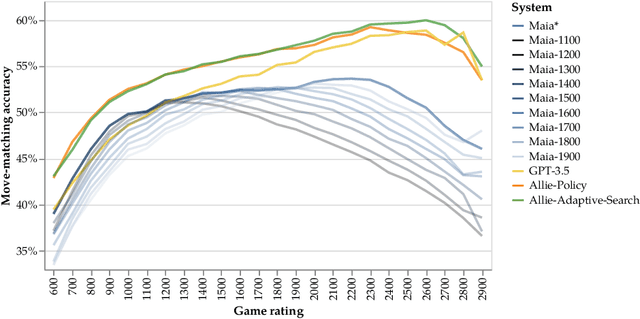

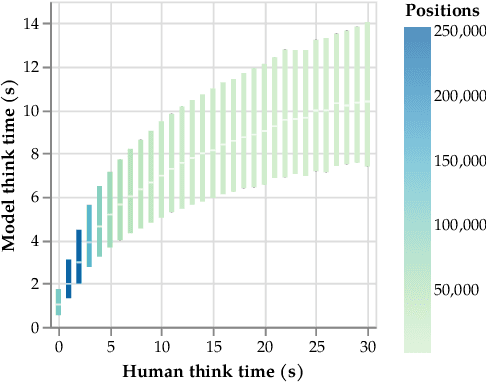
Abstract:Chess has long been a testbed for AI's quest to match human intelligence, and in recent years, chess AI systems have surpassed the strongest humans at the game. However, these systems are not human-aligned; they are unable to match the skill levels of all human partners or model human-like behaviors beyond piece movement. In this paper, we introduce Allie, a chess-playing AI designed to bridge the gap between artificial and human intelligence in this classic game. Allie is trained on log sequences of real chess games to model the behaviors of human chess players across the skill spectrum, including non-move behaviors such as pondering times and resignations In offline evaluations, we find that Allie exhibits humanlike behavior: it outperforms the existing state-of-the-art in human chess move prediction and "ponders" at critical positions. The model learns to reliably assign reward at each game state, which can be used at inference as a reward function in a novel time-adaptive Monte-Carlo tree search (MCTS) procedure, where the amount of search depends on how long humans would think in the same positions. Adaptive search enables remarkable skill calibration; in a large-scale online evaluation against players with ratings from 1000 to 2600 Elo, our adaptive search method leads to a skill gap of only 49 Elo on average, substantially outperforming search-free and standard MCTS baselines. Against grandmaster-level (2500 Elo) opponents, Allie with adaptive search exhibits the strength of a fellow grandmaster, all while learning exclusively from humans.
Customizing Large Language Model Generation Style using Parameter-Efficient Finetuning
Sep 06, 2024
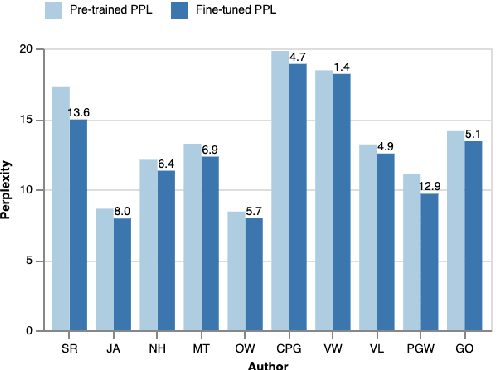
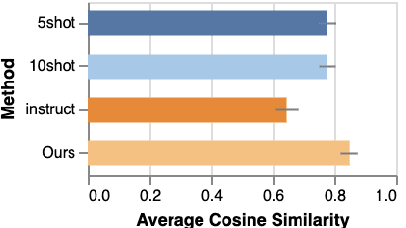
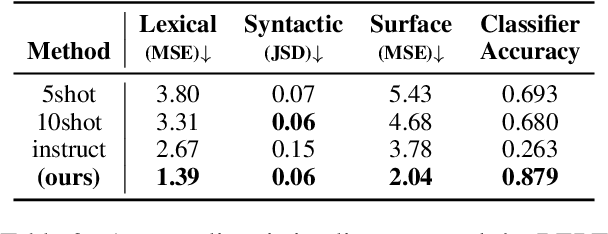
Abstract:One-size-fits-all large language models (LLMs) are increasingly being used to help people with their writing. However, the style these models are trained to write in may not suit all users or use cases. LLMs would be more useful as writing assistants if their idiolect could be customized to match each user. In this paper, we explore whether parameter-efficient finetuning (PEFT) with Low-Rank Adaptation can effectively guide the style of LLM generations. We use this method to customize LLaMA-2 to ten different authors and show that the generated text has lexical, syntactic, and surface alignment with the target author but struggles with content memorization. Our findings highlight the potential of PEFT to support efficient, user-level customization of LLMs.
Consent in Crisis: The Rapid Decline of the AI Data Commons
Jul 24, 2024


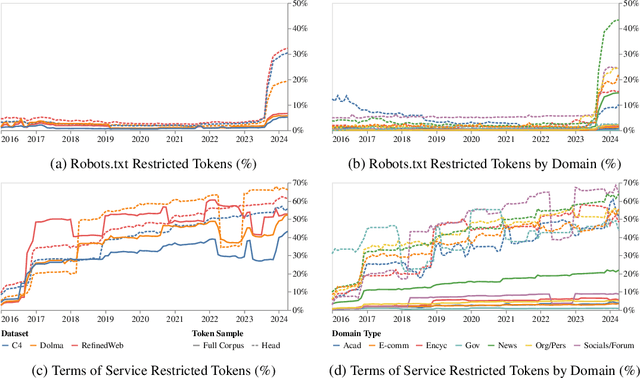
Abstract:General-purpose artificial intelligence (AI) systems are built on massive swathes of public web data, assembled into corpora such as C4, RefinedWeb, and Dolma. To our knowledge, we conduct the first, large-scale, longitudinal audit of the consent protocols for the web domains underlying AI training corpora. Our audit of 14,000 web domains provides an expansive view of crawlable web data and how codified data use preferences are changing over time. We observe a proliferation of AI-specific clauses to limit use, acute differences in restrictions on AI developers, as well as general inconsistencies between websites' expressed intentions in their Terms of Service and their robots.txt. We diagnose these as symptoms of ineffective web protocols, not designed to cope with the widespread re-purposing of the internet for AI. Our longitudinal analyses show that in a single year (2023-2024) there has been a rapid crescendo of data restrictions from web sources, rendering ~5%+ of all tokens in C4, or 28%+ of the most actively maintained, critical sources in C4, fully restricted from use. For Terms of Service crawling restrictions, a full 45% of C4 is now restricted. If respected or enforced, these restrictions are rapidly biasing the diversity, freshness, and scaling laws for general-purpose AI systems. We hope to illustrate the emerging crises in data consent, for both developers and creators. The foreclosure of much of the open web will impact not only commercial AI, but also non-commercial AI and academic research.
RAID: A Shared Benchmark for Robust Evaluation of Machine-Generated Text Detectors
May 13, 2024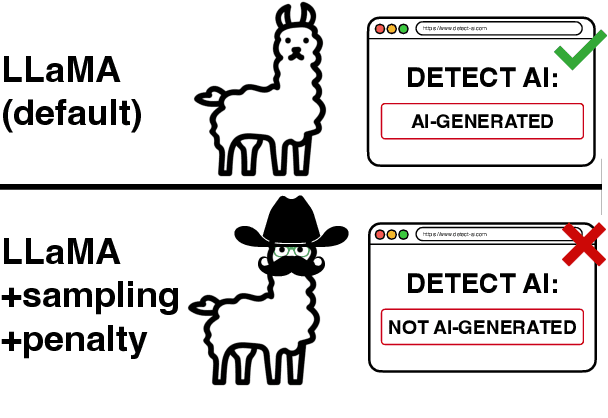
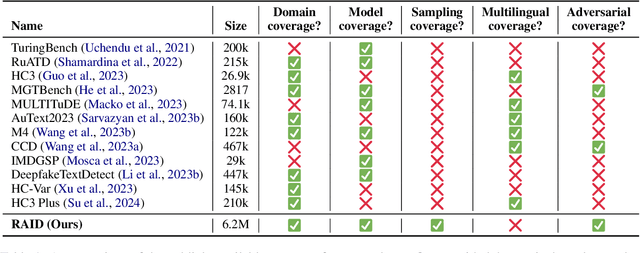
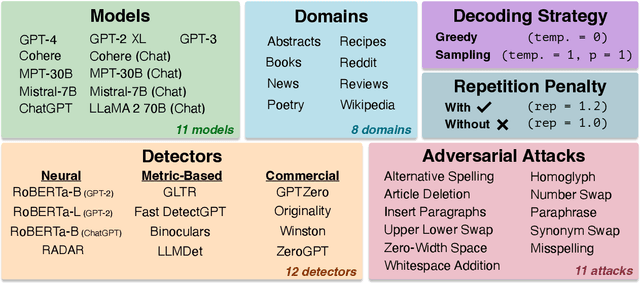
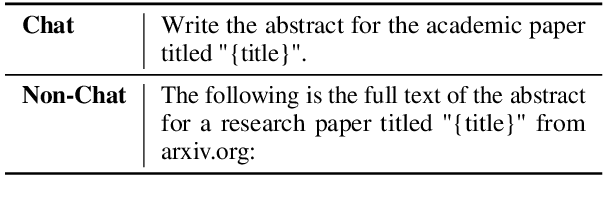
Abstract:Many commercial and open-source models claim to detect machine-generated text with very high accuracy (99\% or higher). However, very few of these detectors are evaluated on shared benchmark datasets and even when they are, the datasets used for evaluation are insufficiently challenging -- lacking variations in sampling strategy, adversarial attacks, and open-source generative models. In this work we present RAID: the largest and most challenging benchmark dataset for machine-generated text detection. RAID includes over 6 million generations spanning 11 models, 8 domains, 11 adversarial attacks and 4 decoding strategies. Using RAID, we evaluate the out-of-domain and adversarial robustness of 8 open- and 4 closed-source detectors and find that current detectors are easily fooled by adversarial attacks, variations in sampling strategies, repetition penalties, and unseen generative models. We release our dataset and tools to encourage further exploration into detector robustness.
 Add to Chrome
Add to Chrome Add to Firefox
Add to Firefox Add to Edge
Add to Edge